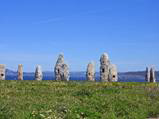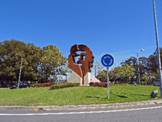After several stops in Portugal we arrived in Spain – – again – – this time at the northwest corner in a region called Galicia. The port was somewhat colder and windier than previous stops, no surprise since we′re farther north. Although Galicia is part of Spain, it has lots of features not typical of the rest of Spain: it is often described as green and drizzly (but we had beautiful weather); the coast is deeply indented with fingers of ocean that look like fjords; the area was settled by Celts in 600 B.C. (!) and people say that even today this area is a bit of "Irish Spain"; and, as if to prove the last point, the local musical instrument here is the gaita, a cousin to the bagpipe; the Moors were not as prevalent here as in other parts of Spain so many of the inhabitants have blue or green Celtic eyes, not the brown eyes seen in the rest of Spain.
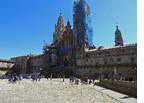 Our first destination was the UNESCO World Heritage Site, Santiago de Compostela, a medieval town built around a cathedral dedicated to St James. We began in the town square which had the Cathedral on one side, the town hall opposite, a hotel on the third side, and an early university on the fourth. The Cathedral, started in the 11th century, was a pilgrimage site even before then. In addition to the typical tourists like us, there are numerous groups of people who continue to hike to the site starting from France or other distant locations to carry on the pilgrimage tradition. Another tradition is the scallop shell. Long ago the pilgrims would take home a scallop shell, one only available in the Galicia region, to prove they′d gotten to Compostela. Perhaps indicative of the long walks the modern day pilgrims make, the hawkers around the square sell canes as souvenirs. I would have thought that the walking pilgrims would have started out with a cane or walking stick, not acquire one at their halfway point in Compostela.
Our first destination was the UNESCO World Heritage Site, Santiago de Compostela, a medieval town built around a cathedral dedicated to St James. We began in the town square which had the Cathedral on one side, the town hall opposite, a hotel on the third side, and an early university on the fourth. The Cathedral, started in the 11th century, was a pilgrimage site even before then. In addition to the typical tourists like us, there are numerous groups of people who continue to hike to the site starting from France or other distant locations to carry on the pilgrimage tradition. Another tradition is the scallop shell. Long ago the pilgrims would take home a scallop shell, one only available in the Galicia region, to prove they′d gotten to Compostela. Perhaps indicative of the long walks the modern day pilgrims make, the hawkers around the square sell canes as souvenirs. I would have thought that the walking pilgrims would have started out with a cane or walking stick, not acquire one at their halfway point in Compostela.
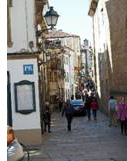 We then walked around the old town surrounding the Cathedral. The narrow streets, of hewn blocks of stone, are closed to all traffic but taxis. There are endless restaurants and bars, one after the other. The streets open up into one plaza after another, giving the city a Venice–like appearance.
We then walked around the old town surrounding the Cathedral. The narrow streets, of hewn blocks of stone, are closed to all traffic but taxis. There are endless restaurants and bars, one after the other. The streets open up into one plaza after another, giving the city a Venice–like appearance.
And of course, there are churches. Through the centuries every religious order, and almost every king including non–Spanish ones, wanted to have a visible presence here. All told, there are 80 churches. Many are no longer in use but the Catholic Church continues to maintain the buildings and apparently offer the unused ones for community meetings, etc.
We then headed back to A Coruna where the ship was berthed. Corona is an interesting city. Its oldest landmark is a Roman tower/lighthouse, The Pillar of Hercules, built almost 2,000 years ago.
One impression of this city is that there are parks and open areas everywhere. It is clean and full of places to walk, run, and bike. A second impression is that there is art everywhere: every roundabout, throughout the open spaces in the parks and along the waterfront.
The sea is within sight from almost every part of the city. There are wide, white sand beaches everywhere, including in the downtown area.
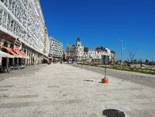 The newer part of A Coruna is filled with houses that the guide called modern but looked more Victorian to me. One of the most common features of apartments that were on the waterfront (in a part of the city called the fisherman′s area) is pop–out balconies. It is so persistently windy and rainy in this part of Spain that these very narrow pop out balconies are totally enclosed by floor–to–ceiling framed glass. This is architecture that is both beautiful and necessary. These glass balconies are necessary because they act as an insulating layer for the main building windows and, because they are glass, a building full of these enclosed balconies looks like a faceted crystal bowl from the outside and on the inside provides residents with lots of light.
The newer part of A Coruna is filled with houses that the guide called modern but looked more Victorian to me. One of the most common features of apartments that were on the waterfront (in a part of the city called the fisherman′s area) is pop–out balconies. It is so persistently windy and rainy in this part of Spain that these very narrow pop out balconies are totally enclosed by floor–to–ceiling framed glass. This is architecture that is both beautiful and necessary. These glass balconies are necessary because they act as an insulating layer for the main building windows and, because they are glass, a building full of these enclosed balconies looks like a faceted crystal bowl from the outside and on the inside provides residents with lots of light.
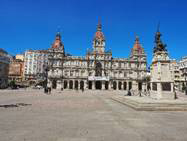 Finally, we ended at another of the old parts of the city which, of course, was built around a city square. Apartments around the perimeter of this square are apparently some of the most sought after in the city and there are shopping areas and high end restaurants radiating out from this core.
Finally, we ended at another of the old parts of the city which, of course, was built around a city square. Apartments around the perimeter of this square are apparently some of the most sought after in the city and there are shopping areas and high end restaurants radiating out from this core.
___________________________________________________
On May THREE we′ll be at SEA so no report will come to THEE!

